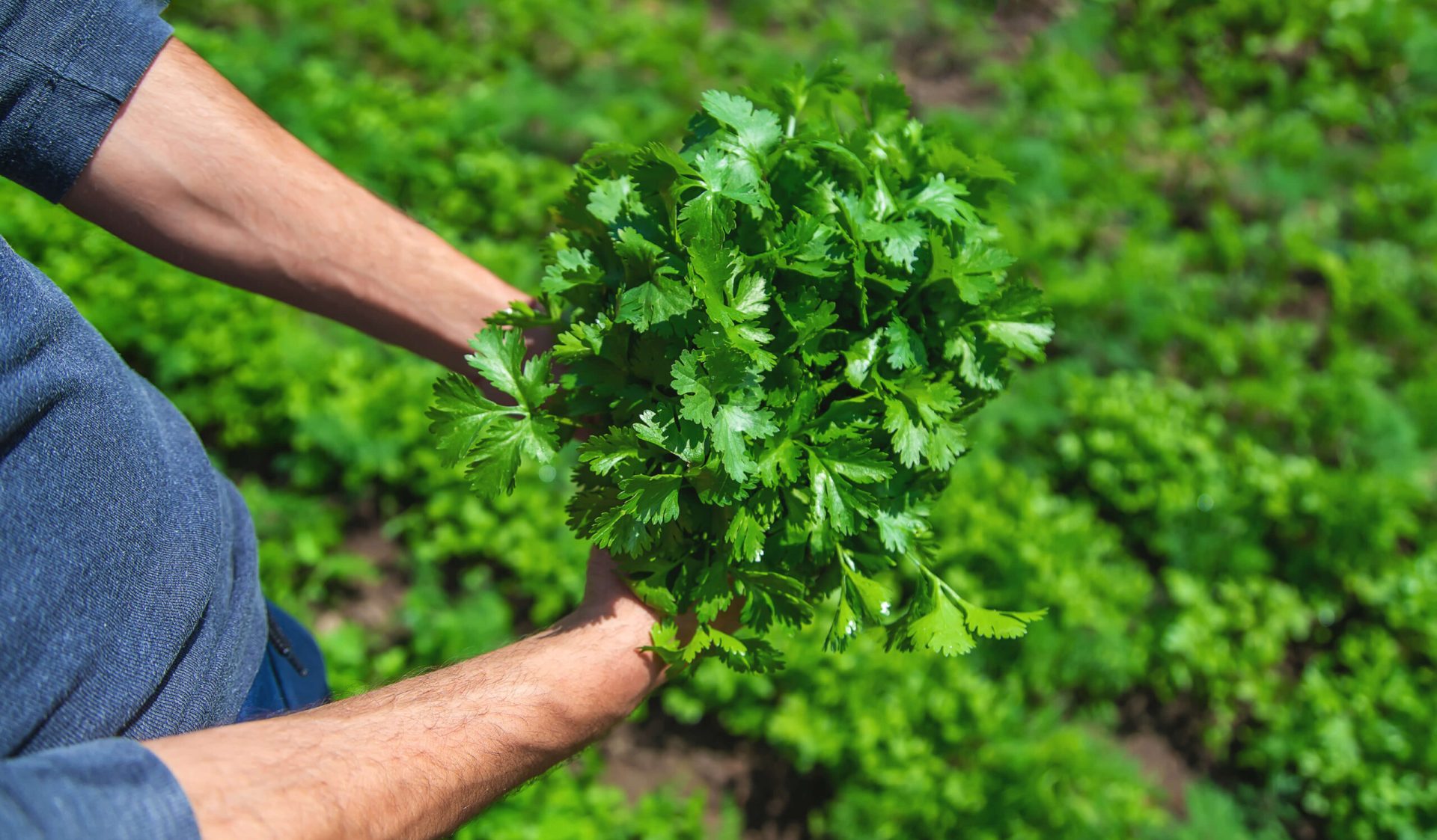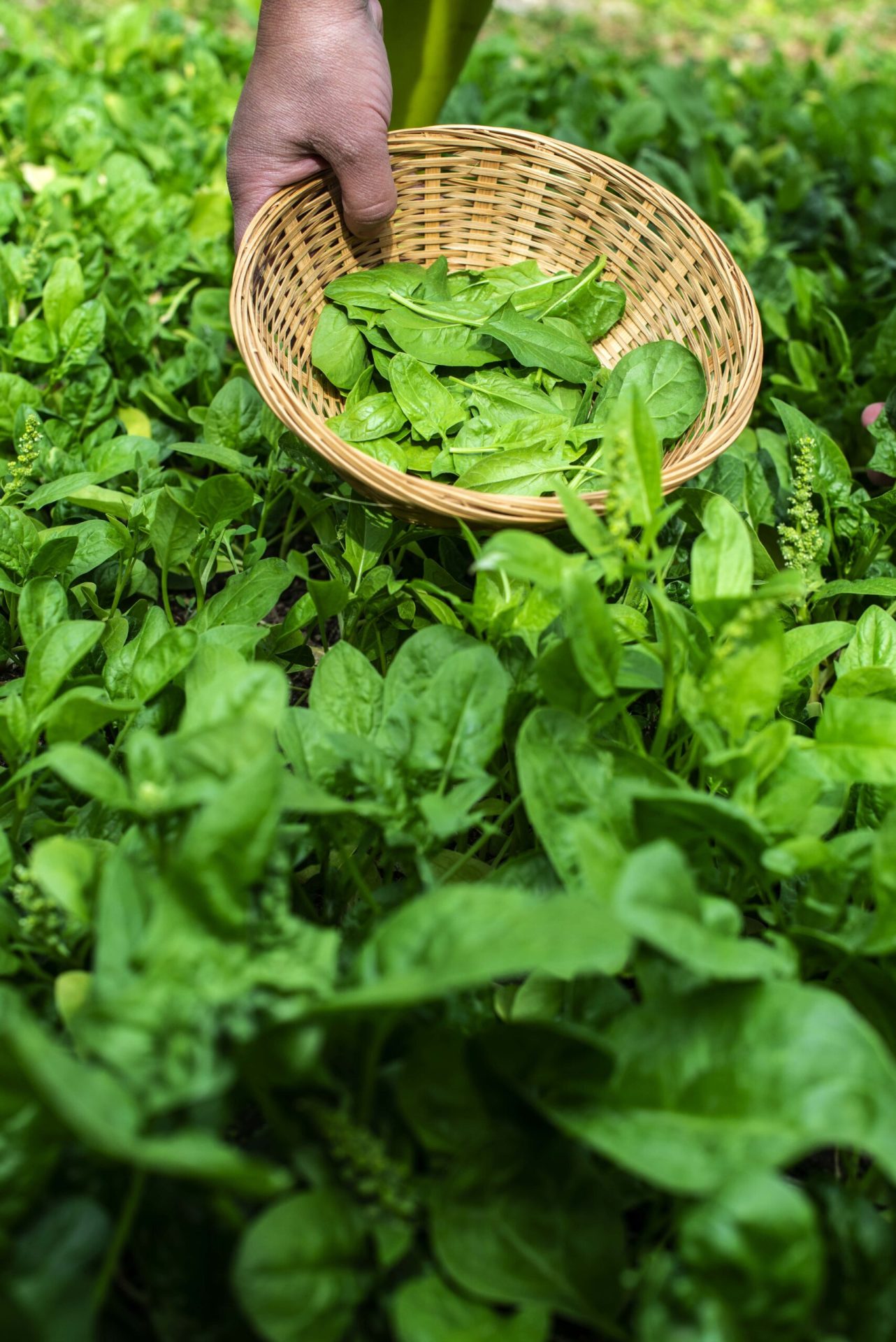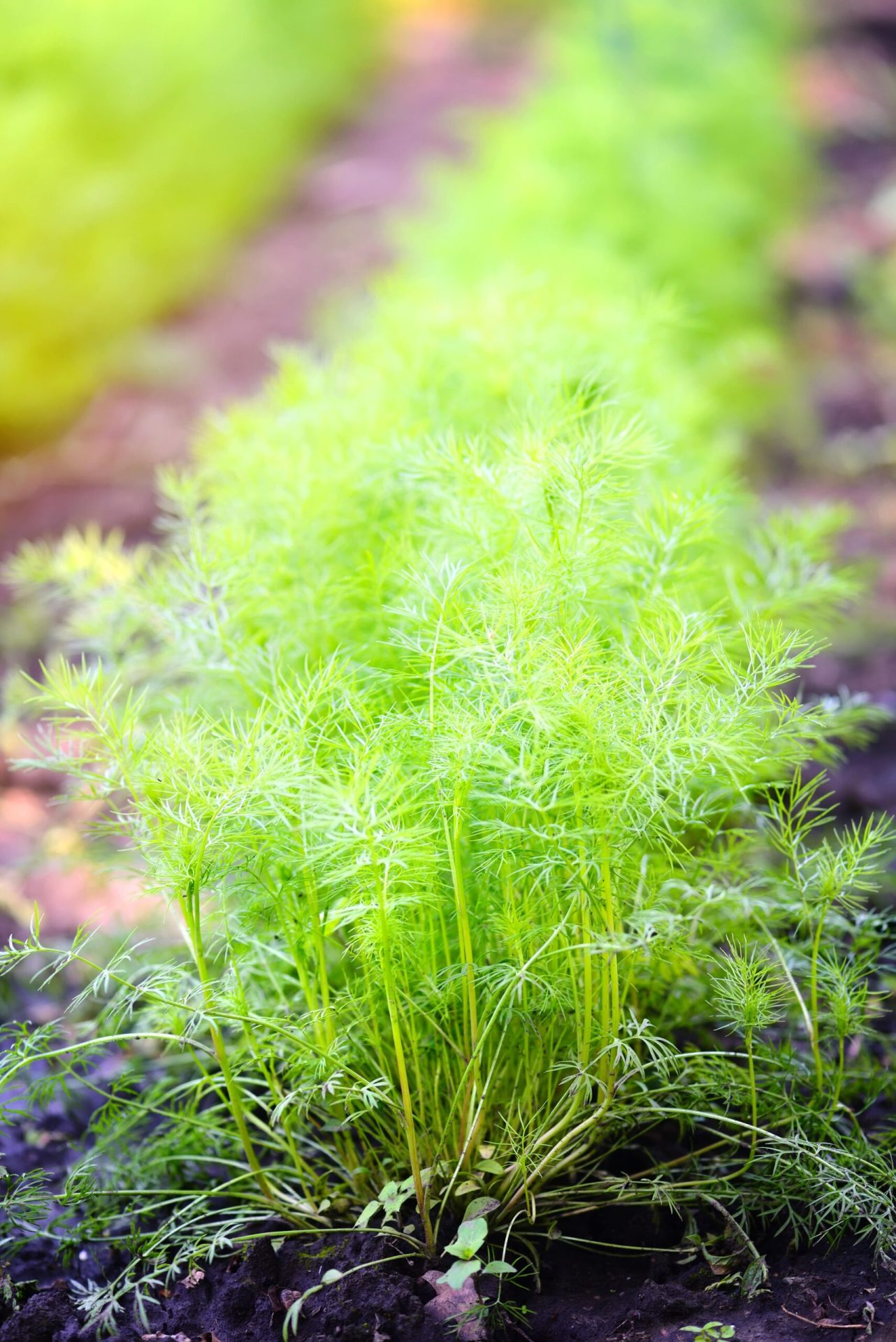Cilantro is a favorite culinary herb, and it holds a special place in different cooking traditions across the globe. Fortunately, it’s a very easy herb to grow. However, cilantro can be fickle in the garden, often bolting when it receives too much heat.
Interested in growing cilantro in your garden? This guide covers everything you need to know. From the cilantro life cycle, to growing tips, follow this growing guide to have your most bountiful harvest of cilantro yet.
Growing Cilantro 101: Step-by-Step Guide
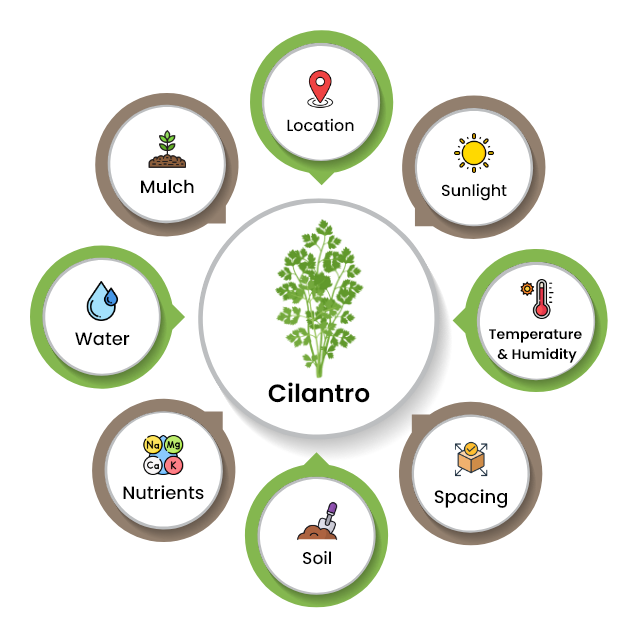
1. Location
Select a place that receives full sun, about 4-6 hours of sunlight daily. Cilantro can tolerate partial shade, especially in hot climates.
2. Temperature and Humidity
Cilantro prefers cooler temperatures between 50°F- 75°F to thrive well.
3. Spacing
Space plants 2 inches apart if you plan to use the plant for leaves.
4. Soil
Cilantro prefers well-drained and moisture-retentive soil rich in organic matter. It should have a pH of 6.0-6.7.
5. Nutrients
Use balanced fertilizer or compost tea every 4-6 weeks during the growing season.
6. Water
Cilantro requires an inch of water per week for its best growth. Ensure the soil is moist, but not water-logged.
7. Mulch
Add a 3-inch layer of mulch to preserve soil moisture and prevent weeds.
How to Grow Cilantro from Seed?
- Before you plant cilantro seeds, you should prepare them to increase their chances of germination.
- TIP: Soak the seeds in water for about 24-48 hours. Remove them from the water and allow them to dry.
- Cilantro can be grown either indoors or outdoors.
- Sow cilantro seeds about ¼ inch deep in the soil.
- Space them 6 to 8 inches apart.
- Cover the seeds with soil and keep them moist.
- Once the seedlings emerge and develop their first true leaves, thin them out to prevent overcrowding.
- Apply balanced fertilizer or compost twice during the growing season for healthy growth of cilantro.
How to Grow Cilantro in Containers?
Choose a good quality container that is deep and wide enough for growing this green herb.
- For growing cilantro in containers, choose one with 18 inches width and 10-12 inches depth.
- Ensure it has suitable drainage holes to prevent waterlogging.
- Use a well-draining potting mix that has good moisture retention.
- Fill the container with potting mix, leaving an inch of space below the rim.
- Sprinkle seeds evenly over the surface of the soil.
- Cover them lightly with a thin layer of potting mix.
- Place the container in a location where it receives at least 6-8 hours of sunlight daily.
- Use balanced fertilizer or organic compost tea every 4-6 weeks during the growing season.
- Cilantro plants are ready for harvest when they are about 6-8 inches tall.
How to Transplant Cilantro Seedlings?
Even though coriander is easy to grow and care for, it can be tricky to transplant. Below are useful steps to transplant cilantro seedlings successfully:
- The best time to transplant seedlings is about 2-3 weeks after the last frost date.
- When transplanting, you should plant the seedlings in a location that receives partial shade.
- Before planting seedlings, include organic material in at least the top 6 inches of your garden.
- Dig holes deep enough, about 3-4 inches, to accommodate the taproots of seedlings.
- Leave 8-12 inches between holes and 12-15 inches between rows.
- To remove seedlings from pots without damaging their roots, use a trowel to dig a wide circle around each plant before lifting it.
- Remove the seedlings gently from the small circles and insert them immediately in their designated holes in the garden.
- Gently fill the excess space in the hole with soil.
- You may need to water seedlings in the first week to help the plant establish itself.
When to Plant Cilantro?
- Plant it during the cool days of spring or fall.
- Mix several inches of aged compost or rich organic matter to improve soil.
- Sow seeds at intervals of 2-3 weeks to constantly harvest fresh leaves.
- Set out transplants 2-3 weeks after the last spring frost.
How to Plant Cilantro?
- It requires rich and well-draining soil, which has a pH of 6.2-6.8.
- Select a location that receives 4-6 hours of sunlight.
- Before planting, loosen the soil to a 6-8 inches depth and remove weeds.
- Sow the seeds directly into the prepared soil.
- Space them about 6-8 inches apart.
- Plant them about ½ to ¼ inch deep and cover them lightly with soil.
- Water seeds immediately after planting to ensure good soil contact.
- Keep the soil moist during germination, which takes 7-14 days.
Cilantro Growing Stages

The lifecycle of cilantro plants starts with a tiny seed and ends with aromatic leaves and flavorful seeds. Let us understand about each growing stage in brief:
1. Seed stage
The lifecycle of cilantro starts with a seed. Its seeds are small, light, and brown. For the germination process to begin, plant your cilantro seeds in a loose and well-draining soil. Keep the soil moist during this stage for proper seed development.
2. Germination stage
After planting the seeds, they begin to absorb moisture and swell. With the passage of time, they split open, and a small root emerges, followed by the stem and leaves.
In this stage, seeds transform into young plants in 1-2 weeks from the seed germination process. However, it may vary a bit depending on the variety, temperature, and soil conditions.
3. Seedling stage
Once the seeds germinate, they enter the seedling stage. Young plants develop their first set of true leaves, which differs from cotyledon leaves. These are the first true leaves to appear after germination and resemble the characteristic of jagged cilantro leaves.
4. Vegetative stage
The plants develop more branches and leaves in this stage. Adequate sunlight, water, and nutrients are essential to ensure the healthy growth of cilantro.
5. Bolting stage
The plants send up a tall flower stalk for seed production during this stage. The cilantro leaves turn bitter and lose flavor as the plant’s energy is diverted to seed production.
6. Flowering and seed production stage
The cilantro plant develops small white or pink flower clusters on the tall flower stalk. These flowers transform into coriander seeds. Seeds mature and become ready for harvest.
How to Harvest Cilantro?
Frequent clipping of leaves makes cilantro grow stronger and stockier; this herb is no exception. Put these leaves in the refrigerator until you are ready to use these leaves for cooking.
The general thumb rule to harvest cilantro is to consume up to 30% of a single plant at a time.
- Cilantro is ready to harvest when it has tender green leaves and grows about 6-8 inches in height before it bolts.
- Depending on their growing conditions, it takes about 4-6 weeks for your plants to reach maturity and get ready for harvest.
- Working with the outer stems is best because the outer stems are the oldest.
- To harvest only the cilantro leaves, clip them off near the plant’s stem using gardening shears.
- If you selectively harvest cilantro, leave some leaves and stems on the plant to continue growing.
- This will ensure continued harvest throughout its growing season.
How to Store Cilantro?
Cilantro will wilt and turn brown when not taken care of properly. If you want to wait to wash your herbs after buying them, you can store them properly for later use. Before using, wash cilantro properly in the water to remove dirt or debris.
- Trim the ends of the cilantro and remove any wilted or yellow leaves.
- Wrap the unwashed bunch of cilantro leaves in a clean paper towel.
- Roll the cilantro bunch from one end to the other by covering it thoroughly.
- Place it in a plastic storage bag.
- Store it in the vegetable crisper drawer of your refrigerator.
- The cool temperature of refrigerator slows the cilantro’s wilting process and keeps it fresh for a long time.
- At regular intervals, you need to check the cilantro for any signs of wilting or spoilage.
- Remove yellow or slimy leaves to prolong the freshness of the cilantro.
Best Cilantro Varieties
1. Santo Cilantro
This cilantro variety is favored for its vigorous growth habit and robust flavor. It is one of the strongest varieties, bred to be bolt-resistant. It takes longer to flower, and its leaves become ready for harvest longer.
It produces large flavorful leaves with a citrusy and slightly spicy taste. This cilantro variety is suitable for culinary use in salads, salsas, and soups.
2. Calypso Cilantro
This cilantro variety is highly valued for its growing properties. It has a strong, aromatic flavor, and slow bolting characteristics. It produces dark green, serrated leaves with a traditional cilantro taste.
This cilantro is suitable for indoor and outdoor cultivation and thrives well in different climates. This variety has good resistance to bolting. It allows for an extended harvest window and continuous leaf production.
3. Delfino Cilantro
This unique cilantro variety has fern-like leaves and dense foliage. It produces a high yield compared to other varieties. Its leaves and seeds are edible. It has a much softer taste than regular cilantro taste.
A staple for summer salsa dishes, this variety bolts slowly and thrives well in hot weather. To add flavors, it can be chopped perfectly in fish curry, soups, and gravies.
Common Pests and Diseases Problems with Cilantro
Like other herbs, cilantro can fall victim to various pests and diseases. Pests that affect the growth of cilantro are aphids, whiteflies, spider mites, caterpillars, slugs, and snails. Diseases that affect its growth are powdery mildew, fusarium wilt, damping off, bacterial leaf spot, and downy mildew.
To avoid problems, keep things clean, space plants apart for air circulation, and check for bugs and diseases often.
Use organic or chemical treatments like insecticidal soap for pests and fungicides for fungal diseases, following label instructions carefully.
Selecting disease-resistant varieties and following crop rotation can help mitigate recurring problems.
Companion Plants for Cilantro
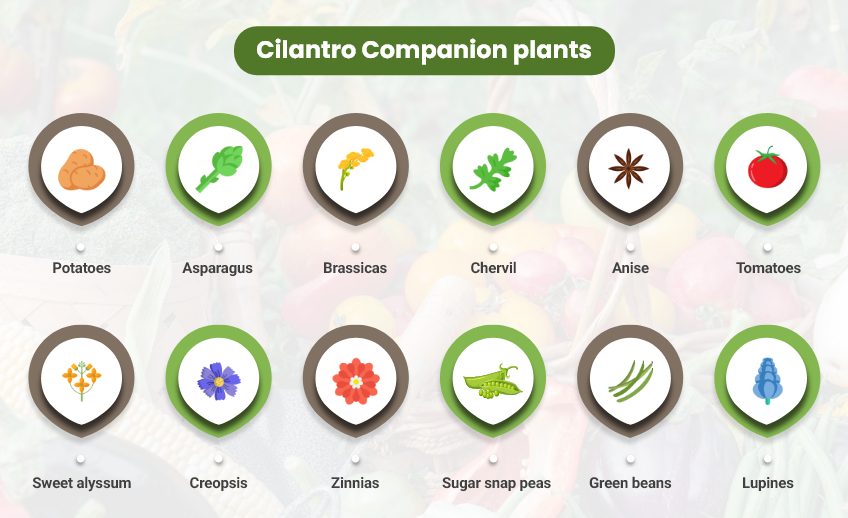
Cilantro is a cool-weather crop that is fast-growing and easy to harvest. It is the best companion for several plants in your garden. Reason? It helps attract beneficial insects and grows faster.
Try companion planting for cilantro to maximize the efficiency and health of your home garden’s crop. Companion plants for cilantro are Anise, dill, mint, parsley, leafy vegetables, legumes, potato, tomato, and other water-loving herbs.

